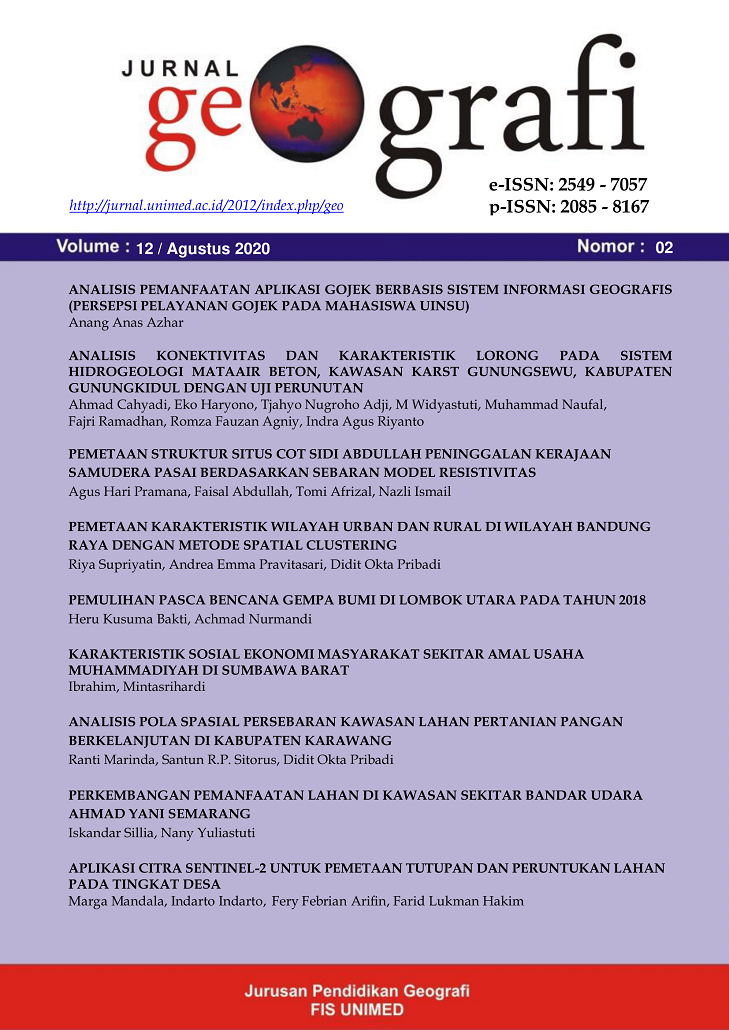PEMETAAN STRUKTUR SITUS COT SIDI ABDULLAH PENINGGALAN KERAJAAN SAMUDERA PASAI BERDASARKAN SEBARAN MODEL RESISTIVITAS
DOI:
https://doi.org/10.24114/jg.v12i02.17205Abstract
Metode DC-Resistivity konfigurasi Wenner telah diaplikasikan pada situs cagar budaya Cot Sidi Abdullah (CSA) di Desa Kuta Krueng, Kecamatan Samudra Pasai, Kabupaten Aceh Utara. Data geolistrik diukur pada 8 lintasan sejajar dengan spasi lintasan 5 meter dari arah utara - selatan sepanjang situs dan spasi elektroda 0,5 meter. Berdasarkan hasil model penampang 2D diperoleh zona yang bersifat konduktif dengan kisaran nilai resistivitas 0,1 “ 80 Ωm dan zona resistif dengan nilai reistivitas berkisar antara 100 “ 600 Ωm dengan ketebalan lapisan 1 meter. Keberadaan zona yang relatif konduktif disebabkan oleh adanya intrusi air asin yang terdapat disekeliling daerah itu, yaitu area tambak dan sungai. Sedangkan zona resistif terdapat secara merata di semua lintasan yang umumnya berada di tengah“tengah lintasan dan dapat diprediksikan sebagai bagian dari situs yang tertimbun dibawah permukaan. Zona resistif berupa batu bata yang berada di sekeliling situs dan menahan intrusi air asin masuk ke tengah. Oleh karena itu bangunan Situs CSA diprediksi memiliki luasan sekitar 26 m x 35 m dengan bangunan sekeliling berupa batu bata dengan ketebalan dinding situs 1,5 meter. Sedangkan bagian tengah adalah timbunan pasir yang tidak dipengaruhi oleh air asin.Kata kunci: Metode geofisika, Arkeologi, Cot Sidi Abdullah, Metode DC - Resistivity, Resolusi Model, RekontruksiThe DC-Resistivity method with Wenner configurations was applied to the cultural heritages of Cot Sidi Abdullah (CSA) in Kuta Krueng Village, Samudra Pasai District, North Aceh Regency. Resistivity data were measured on 8 parallel lines with 5 meterline spacing from north to south of the sites and 0.5 meter electrode spacing. The 2D model results show that there are conductive region with the value of resistivity from 0.1-80 Ωm and resistive region with resistivity values ranging from 100 - 600 with a thickness of 1 meter. The existence of the relatively conductive region is caused by the sea water intrusions which is found surrounding the area, such as fish and river areas. However the resistive region is evenly found in all of the lines which are generally located in the middle of line and it was predicted as a part of Cot Sidi Abdullah site buried under the surface. The resistive region is consist of brick wall structures which surrounding the site can hold the sea water intrusions into the center of the sites. Therefore it can be concluded that the CSA Site has 26 m x 35 m areas which is surrounded by the brick structures with 1.5 meters thick. Howeverthe middle part of the site is filled with a sand material that is not affected by salt water.Key words: Geophysics Method, Archaeology, Cot Sidi Abdullah, DC- Resistivity Method, Model Resolution, ReconstructionReferences
Alashloo, S. M., Saad, R., Nawawi, M. N. M., Saidin, M., & Alashloo, M. M. (2011). Magnetic and 2D electrical imaging methods to investigate an archaeological site at Sungai Batu, Kedah, Malaysia. In 3rd International Conference on Chemical, Biological and Environmental Engineering, IPCBEE (Vol. 20).
Bennet, J., Bridge, D., Cameron, N., Djunuddin, A., Ghazali, S., Jeffery, D., ... & Whandoyo, R. (1981). Peta Geologi Lembar Banda Aceh. Sumatra Skala, 1(250.000).
BPCB Aceh. (2014). Ekskavasi Penyelamatan Struktur Cagar Budaya Cot Sidi Abdullah. Laporan Kegiatan. Aceh Besar. Balai Pelestarian Cagar Budaya Aceh.
Guillaume, B., Francois, L., Vivien, M., Adrien, C., Carole, R., & Ard Vincent. (2015). High spatial resolution magnetic survey on the Neolithic site of Le Pontet (Charente-Maritime, France): presentation of the method and associated processing. International Conference on Metrology for Archaeology Benevento, Italy. https://scanr.enseignementsup-recherche.gouv.fr/publication/hal-01520765
Ismail, N., Yanis, M., Abdullah, F., Irfansyam, A., & Atmojo, B.S.W. (2018). Mapping buried ancient structure using gravity method: A case study from Cot Sidi Abdullah, North Aceh. Jorunal of Physics: Conference Series, 1120 (1), 1-5. https://iopscience.iop.org/article/10.1088/1742-6596/1120/1/012035.
Karavul, C., Dedebali, Z., Keskinsezer, A., Beyhan, G., & Demirkol, A. (2010). Magnetic and electrical resistivity image survey in a buried Adramytteion ancient city in Western Anatolia, Turkey. International Journal of the Physical Sciences Vol. 5(6), page 876-883. https://academicjournals.org/journal/IJPS/article-abstract/947362227302.
Loke, M. (2000). Time-Lapse Resistivity Imaging Inversion. Proceedings of the 5th Meeting of the Environmental and Engineering Geophysical Society European Section, Budapest, Hungary. https://doi.org/10.3997/2214-4609.201406397.
Martorana, R., Capizzi, P., Alessandro, A., Pisciott, A., & Scudero. (2017). GPR and Magnetic Survey at the Kamarina Archaeological Site (Sicily, Italy) Supported by Aerial Photograpic and Thermographic Data. GNGTS. https://iris.unipa.it/handle/10447/245790#.Xk4fYSgzbIV
Mekkawi, M., Hamed, T.A., & Abdellatief, T. (2013). Detailed magnetic survey at Dahshour archeological sites Southwest Cairo, Egypt. NRIAG Journal of Astronomy and Geophysics, Vol. 2, Page 175“183. https://doi.org/10.1016/j.nrjag.2013.06.020.
Moquette, J. P. (1913). De eerste vorsten van Samoedra-Pase (Noord Sumatra). Rapport voor Oudheidkunding Dients.
Persson, K. (2005). Integrated geophysical-geochemical methods for archaeological prospecting. KTH, Land and Water Resources Engineering. https://www.semanticscholar.org/paper/Integrated-geophysical-geochemical-methods-for-Persson/c284f9358f3269620763212d25c5020db81d2731.
Pryambodo, D.G., & Troa, R.A. (2016). Aplikasi Metode Geolistrik untuk Identifikasi Situs Arkeologi di Pulau Laut, Natuna. KALPATARU, Majalah Arkeologi Vol. 2, No. 1, hal. 45-52. http://dx.doi.org/10.24832/kpt.v25i1.82.
Reynolds, J.M. (1997). An Introduction to Aplied and Eviromental Geophysics. Jhon Wiley & Sons. England.
Schmidt, A. (2009). Electrical and Magnetic Methods in Archaeological Prospection. Seeing the Unseen. Geophysics and Landscape Archaeology, page 67-81. http://dx.doi.org/10.1201/9780203889558.pt2
Sumarsih, S. (1985), Risalah Sejarah dan Budaya, Seri Terjemahan Naskah Kuno, Departemen Pendidikan dan Kebudayaan, Direktorat Jendral Kebudayaan, Balai Kajian Sejarah dan Nilai Tradisional. Yogyakarta.
Telford, W. M., Geldart, L. P., & Sheriff, R. E. (1990). Applied Geophysics Second Edition, Cambridge University Press, USA.
Welc, F., Mieszkowski, R., Vrkljan, G.L., & Konestra, A. (2017). An Attempt to Investigation of Different Geophysical Methods (Magnetic, GPR, and ERT); A case Study from The Late Roman Sttlement on The Island of Rab in Croation. Studia Quaternaria, vol. 34, no.1:47“59.
http://dx.doi.org/10.1515/squa-2017-0004.
Young, C.T., & Droege, D.R. (1985). Archaeological applications of resistivity and magnetic methods at Fort Wilkins State Park, Michigan. Geophysics, Vol. 51. No. 3, Page 568-575.
https://doi.org/10.1190/1.1442111
























